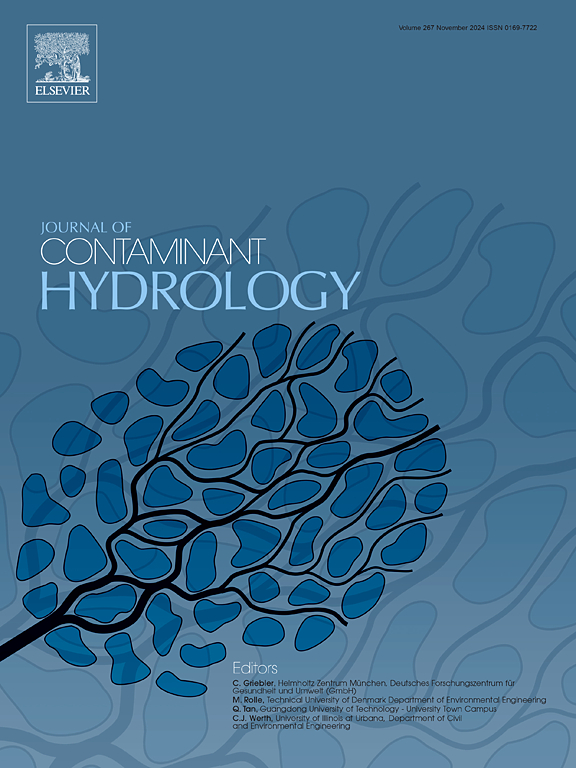Microplastics and organic contaminants: Investigation of the sorption process on different polymer types
IF 3.5
3区 环境科学与生态学
Q2 ENVIRONMENTAL SCIENCES
引用次数: 0
Abstract
The presence of microplastics (MPs) in aquatic environments raises major concerns due to their ability to sorb and transport Emerging Contaminants (ECs). In this work, a sorption study was carried out, using MPs of polyester (PES), polyamide (PA), polyvinyl chloride (PVC), polypropylene (PP), high-density polyethylene (HDPE) and low-density polyethylene (LDPE), in the size range of 63 to 250 μm. Five emerging contaminants (ECs) were selected for this evaluation: Ametryn (AMT), atrazine (ATZ), bisphenol A (BPA), progesterone (PGT) and pyraclostrobin (PCT). The MPs were previously characterized by different analytical techniques and presented results in good agreement with the literature. Sorption experiments presented a predominance in the interaction of the most nonpolar ECs (PCT and PGT), with all six polymers. In general, under the evaluated conditions, the highest sorption percentages were obtained for: PA > PP > LDPE > PVC > HDPE > PES, for 24 h of contact time, that could be considered as the apparent equilibrium time, and the increase in the mass of MPs contributed for the enhancement in the sorption process, probably due to the greater availability of interaction sites. Also, the variation in ionic strength and pH caused no significant effect between the sorption of most ECs and the MPs. The results indicate a greater interaction between MPs and nonpolar contaminants, revealing that MPs play a limited role in the transport of more polar compounds in the aquatic medium.

微塑料和有机污染物:不同类型聚合物吸附过程的研究
微塑料(MPs)具有吸附和迁移新污染物(ECs)的能力,因此在水生环境中的存在引起了人们的极大关注。在这项工作中,我们使用聚酯(PES)、聚酰胺(PA)、聚氯乙烯(PVC)、聚丙烯(PP)、高密度聚乙烯(HDPE)和低密度聚乙烯(LDPE)的微塑料(尺寸范围为 63 到 250 μm)进行了吸附研究。本次评估选择了五种新出现的污染物 (EC):安美曲林 (AMT)、阿特拉津 (ATZ)、双酚 A (BPA)、黄体酮 (PGT) 和吡唑醚菌酯 (PCT)。以前曾用不同的分析技术对这些 MPs 进行过表征,结果与文献资料十分吻合。吸附实验表明,最非极性的 ECs(PCT 和 PGT)与所有六种聚合物之间的相互作用占主导地位。一般来说,在评估条件下,吸附率最高的聚合物是在 24 小时的接触时间(可视为表观平衡时间)内,PA、PP、LDPE、PVC、HDPE 和 PES 的吸附率最高。此外,离子强度和 pH 值的变化对大多数 ECs 和 MPs 的吸附没有显著影响。结果表明,中压物质与非极性污染物之间的相互作用更大,这表明中压物质在水生介质中迁移极性较强的化合物时作用有限。
本文章由计算机程序翻译,如有差异,请以英文原文为准。
求助全文
约1分钟内获得全文
求助全文
来源期刊

Journal of contaminant hydrology
环境科学-地球科学综合
CiteScore
6.80
自引率
2.80%
发文量
129
审稿时长
68 days
期刊介绍:
The Journal of Contaminant Hydrology is an international journal publishing scientific articles pertaining to the contamination of subsurface water resources. Emphasis is placed on investigations of the physical, chemical, and biological processes influencing the behavior and fate of organic and inorganic contaminants in the unsaturated (vadose) and saturated (groundwater) zones, as well as at groundwater-surface water interfaces. The ecological impacts of contaminants transported both from and to aquifers are of interest. Articles on contamination of surface water only, without a link to groundwater, are out of the scope. Broad latitude is allowed in identifying contaminants of interest, and include legacy and emerging pollutants, nutrients, nanoparticles, pathogenic microorganisms (e.g., bacteria, viruses, protozoa), microplastics, and various constituents associated with energy production (e.g., methane, carbon dioxide, hydrogen sulfide).
The journal''s scope embraces a wide range of topics including: experimental investigations of contaminant sorption, diffusion, transformation, volatilization and transport in the surface and subsurface; characterization of soil and aquifer properties only as they influence contaminant behavior; development and testing of mathematical models of contaminant behaviour; innovative techniques for restoration of contaminated sites; development of new tools or techniques for monitoring the extent of soil and groundwater contamination; transformation of contaminants in the hyporheic zone; effects of contaminants traversing the hyporheic zone on surface water and groundwater ecosystems; subsurface carbon sequestration and/or turnover; and migration of fluids associated with energy production into groundwater.
 求助内容:
求助内容: 应助结果提醒方式:
应助结果提醒方式:


